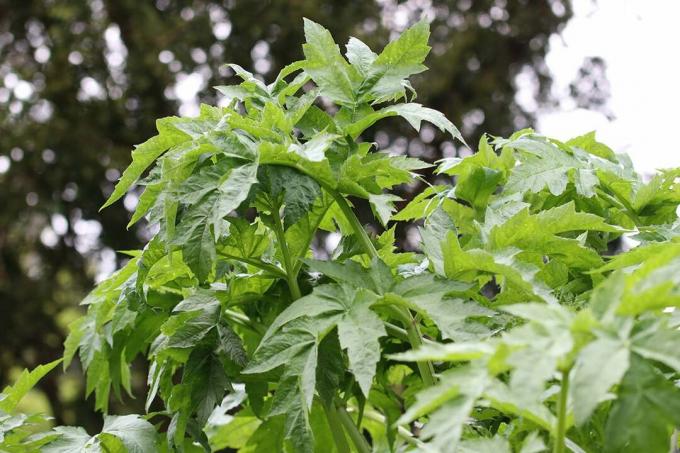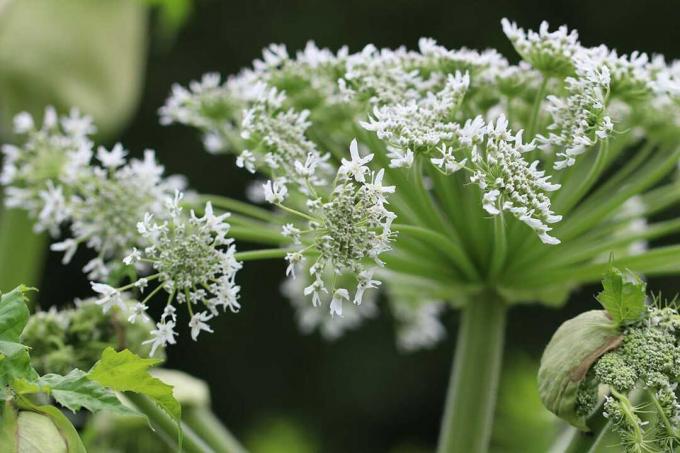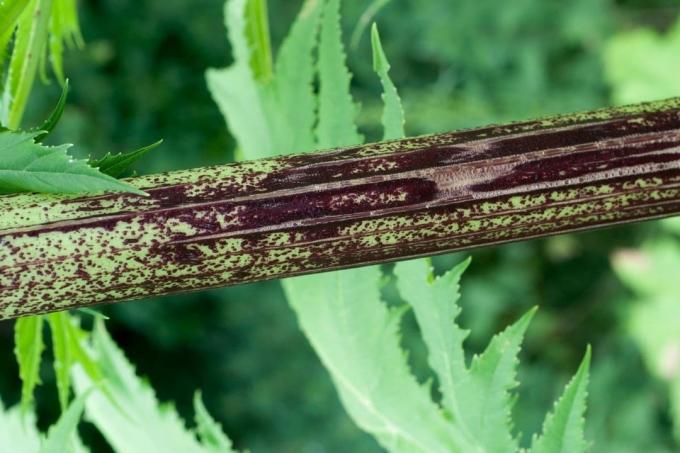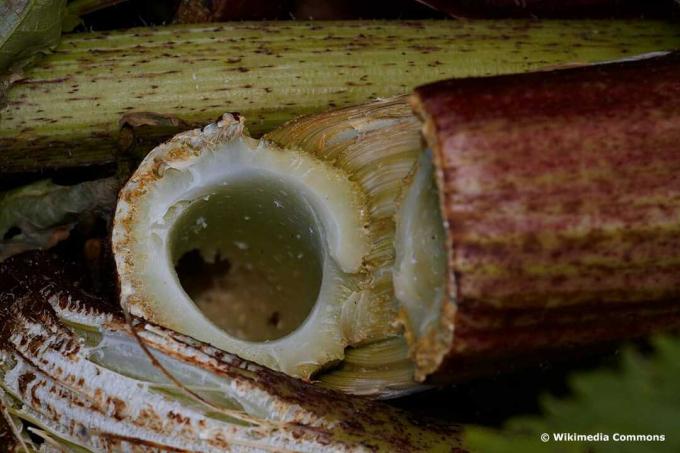
table of contents
- size
- Flowers and fruits
- Stalk
- Sap, leaves & roots
- Removal and disposal
- Signs of burns
- frequently asked Questions
Recognizing giant hogweed is very important in order to be able to remove the plant with the botanical name Heracleum mantegazzianum correctly and specifically. Giant hogweed burns are painful and dangerous.
In a nutshell
- characteristic color of the stem at the lower end
- stands out due to its size
- Contact with the sap is particularly dangerous
- Giant hogweed contains phototoxic substances
- Burns can be severe
size
In the first year there is only a low rosette of leaves, which is hardly noticeable in natural corners. Only from the second year does the height increase enormously. Heights of three to five meters are possible.

Flowers and fruits
The flowers of the giant hogweed are characteristic and comparatively easy to distinguish from other plants. The characteristics include:
- The flower color is white
- Flowering period from June to July
- Double umbels
- Total size of the inflorescences up to 50 centimeters
- Size of the individual flowers from 0.4 to 2.0 centimeters

In addition to these points, it is noticeable that the flowers in the center are significantly smaller than the specimens on the edge. In addition, there can be up to 8,000 of them on one plant. This makes it easy to spot the giant hogweed.
Fruiting bodies, each containing two seeds, develop from them. So it is possible that twice as many seeds emerge after ripening and that an immense spread takes place. It is therefore important to remove at least the flowers as quickly as possible.
Stalk
The stems also have distinctive features and can help identify the giant hogweed. They are:
- measures up to 10 centimeters in diameter
- hollow
- spiked
- purple spots at the bottom
- has grooves

Sap, leaves & roots
To avoid being burned by the giant hogweed, you need to know that all parts of the plant are poisonous. This includes:
- leaves
- blossoms
- Sap
- Stalk
- root

Note: Even if it is often claimed that only the juice is toxic, this is not the case. Although this contains the highest amount of phototoxic substances, a simple touch of the leaves is enough for a burn.
Removal and disposal
In order to get rid of giant hogweed and be safe yourself, you first need appropriate protection. This should consist of the following utensils:
- tight and solid garbage bags
- gloves
- protective suit
- Safety glasses or visor
- spade
- Telescopic loppers
Then proceed as follows:
-
Side shoots and flowers: Shorten the protruding plant shoots piece by piece. This allows you to keep the parts small and dispose of them more easily.
-
Stem: Do the same here. Shorten the stem piece by piece. This offers more security and simplifies disposal. If pruning shears aren't enough, you can also use a saw.
-
Root: Hogweed burns are also possible due to contact with the roots. They must therefore also be removed. Dig up the root ball completely and dispose of it along with the earth.
-
Disposal: You should not put the clippings on top of the compost due to their toxicity. Instead, dispose of it well packed with household waste.
- Cleaning: Then rinse and disinfect the cutting tool and your protective clothing. Otherwise, the sap can still cause burns.
Tips: The sooner you recognize the growth and remove it, the easier the process is. If necessary, you can also contact the Conservation Association inform and ask for help.
To keep the hassle as low as possible, you can put a trash bag in a bucket or tub. This makes it possible to insert the clippings easily and quickly, as well as directly with the cutting tool.
Signs of burns
Giant hogweed burns are more than uncomfortable. They are very painful and can lead to scarring. Typical symptoms are:
- Blistering
- Burn
- Redness
- pains
- swelling

However, these reactions do not always occur immediately. Since it is a Plant with phototoxic substances the signs only appear when the skin has also been exposed to sunlight. So there may be a delay of several hours or even days before the first signs show.
Giant hogweed burns shouldn't be taken lightly. See a doctor immediately and cool the wounds.
frequently asked Questions
No, there is no obligation to do so. Nevertheless, it makes sense to inform the community and thus be able to warn others before it spreads over a wide area. In addition, the nature conservation association can help to identify the plant correctly and in some cases even take over the removal.
Even if it's in an area inaccessible to children and pets, it's a good idea to get rid of it. Otherwise, the two to three year old plant will continue to spread.
The dangerous plants can reproduce and spread through their seeds for several years. Therefore, carry out the removal at the latest at the beginning of flowering.
